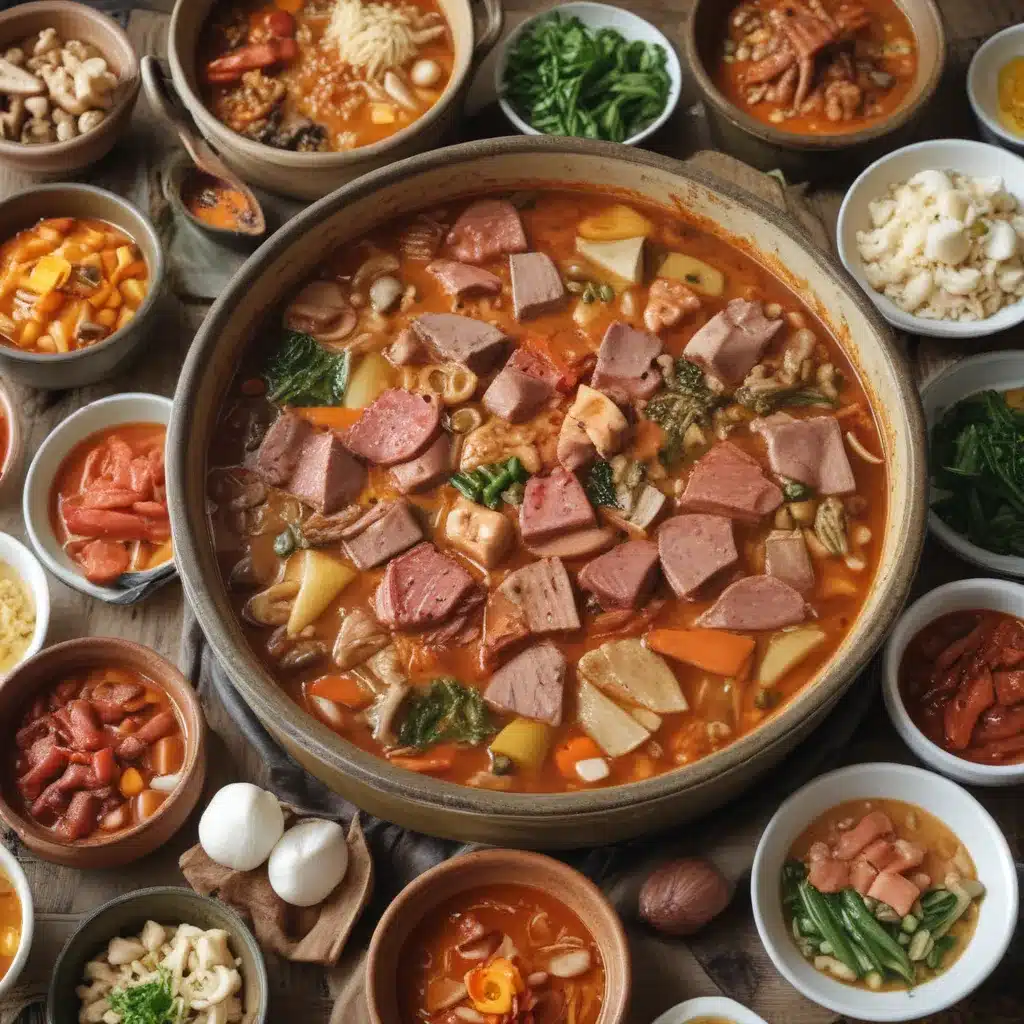
Unraveling the Savory Saga of Budae Jjigae
Picture this: The year is 1953, the Korean War is raging on, and the citizens of South Korea are facing a grim reality – starvation. Amidst the chaos, a culinary masterpiece was born, a dish that would forever capture the resilience and ingenuity of the Korean people. Welcome to the extraordinary tale of budae jjigae, or the “Korean Army Stew.”
From Scraps to Sustenance
As the war devastated the Korean peninsula, the people found themselves in dire need of sustenance. With resources scarce, they turned to the nearby American military bases, scavenging for any scraps of food they could find. These discarded leftovers, often consisting of canned meats like Spam, sausages, and even baked beans, became the foundation of a new dish. [1]
The early iterations of this stew, affectionately dubbed “kkulkkuri-juk” or “piggy porridge,” were a conglomeration of whatever edible items could be salvaged. [2] Imagine a culinary patchwork quilt, stitched together with the odds and ends of the American military’s surplus. These humble beginnings, born out of necessity, would eventually evolve into the vibrant and flavorful budae jjigae we know today.
The Transformation of a Dish
As the years passed and the economy slowly recovered, budae jjigae began to shed its scrappy origins and transform into a beloved comfort food. [3] The addition of ingredients like kimchi, instant ramen noodles, and gochujang (Korean chili paste) elevated the dish, creating a unique fusion of Korean and American flavors. [4]
One woman, Heo Gi-Suk, a North Korean defector, claimed to be the original inventor of budae jjigae. Working at a fishcake stand in Uijeongbu, she started experimenting with the meats obtained from nearby military bases, ultimately creating the first version of the stew. [5] Her restaurant, Odeng Sikdang, became a local institution, drawing in crowds eager to enjoy this unexpected culinary delight.
A Dish Steeped in History
The evolution of budae jjigae is inextricably linked to the tumultuous history of the Korean Peninsula. The dish serves as a powerful metaphor for the country’s resilience, as it transformed hardship into something delicious and comforting. [6] Even the name “budae,” which refers to the military camps, is a testament to the dish’s origins. [7]
However, the dish’s legacy is not without its complexities. Some older Koreans view it as a painful reminder of a bygone era, when they had to rely on the generosity (or waste) of the American military to survive. [8] There are even efforts to rename the dish, like the city of Uijeongbu’s unsuccessful attempt to rebrand it as “Uijeongbu-jjigae.” [9]
Budae Jjigae’s Global Reach
Despite its contentious history, budae jjigae has found its way into the hearts and stomachs of people around the world. From its humble beginnings as a survival food, the dish has now become a celebrated part of Korean cuisine, with restaurants and even Michelin-starred chefs proudly serving their own unique interpretations. [10]
In a twist of fate, the very ingredients that were once seen as lowly and undesirable have now become sought-after delicacies. Spam, once the subject of jokes and derision, is now an integral part of the dish, imbuing it with a salty, savory goodness that has captivated diners globally. [11]
A Dish for the Ages
As we delve into the rich history of budae jjigae, we uncover a story that is as complex as the dish itself. From the depths of war-torn despair to the heights of global culinary acclaim, this Korean army stew has weathered the storms of history, emerging as a testament to the resilience and creativity of the Korean people.
Whether you relish the nostalgic flavors of this dish or approach it with a more critical eye, one thing is certain: budae jjigae is a culinary marvel that will continue to captivate and inspire for generations to come. So grab a spoon, dive into the depths of this savory stew, and let the flavors of history dance across your palate.
References:
[1] https://en.wikipedia.org/wiki/Budae-jjigae
[2] https://www.military.com/history/popular-korean-dish-came-aftermath-of-korean-war.html
[3] https://mangoshomekitchen.com/best-korean-army-stew-recipe-budae-jjigae-recipe/
[4] https://mykoreankitchen.com/army-stew-budae-jjigae/
[5] https://creatrip.com/en/blog/8870/
[6] https://www.cafemaddy.com/blog/budaejjigae
[7] https://omnivorescookbook.com/budae-jjigae/
[8] https://www.reddit.com/r/Cooking/comments/gnluae/korean_army_stew/
[9] https://en.wikipedia.org/wiki/Budae-jjigae
[10] https://www.bbc.com/news/world-asia-53447682
[11] https://www.nytimes.com/2019/11/26/dining/budae-jjigae-army-stew-recipe.html
